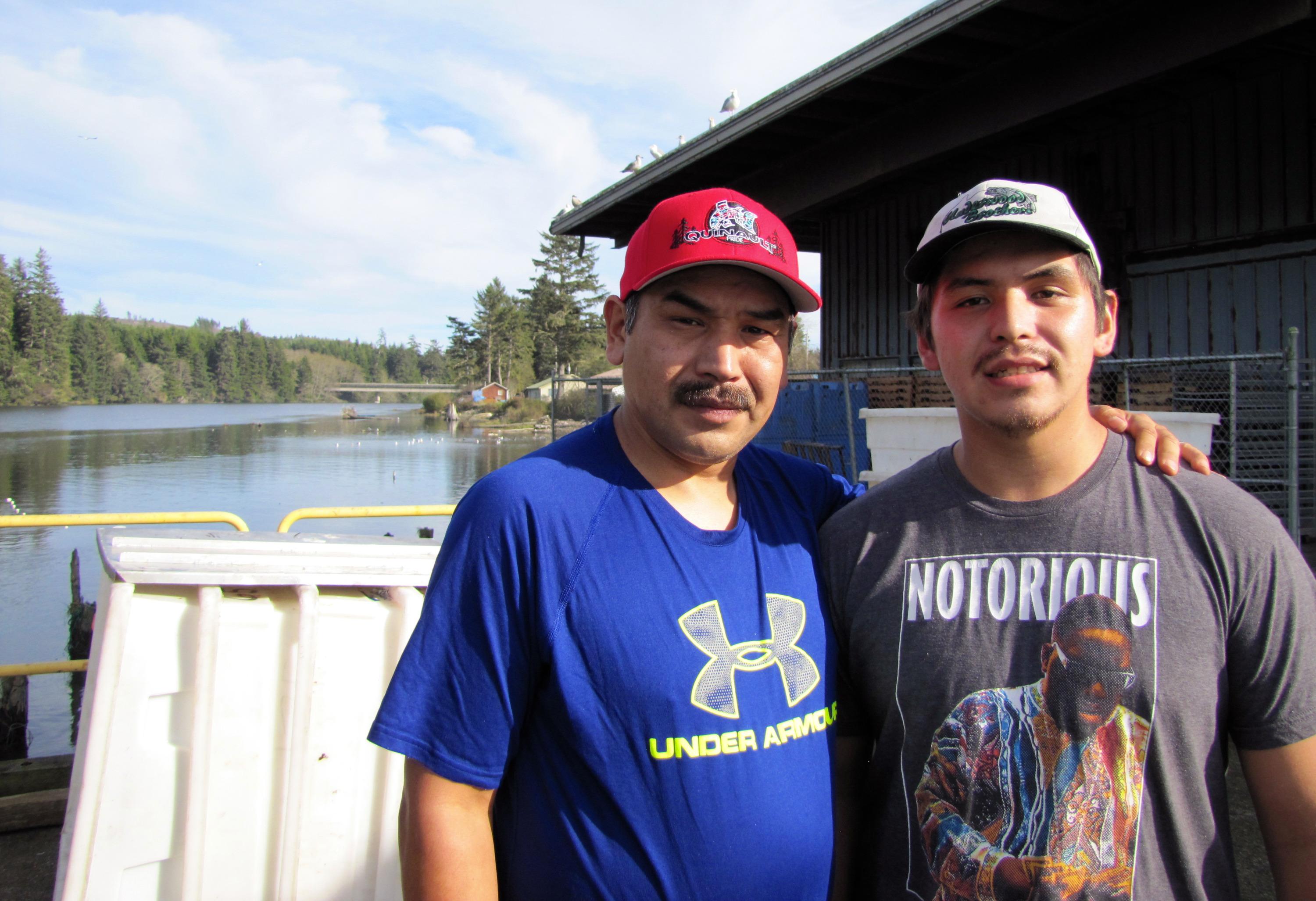
Shane Underwood (left) and his son, David, stand at the Quinault Indian Nation’s seafood plant in Taholah, Washington. The loss of the largest glacier that feeds the Quinault River and rising seas are threatening the tribe’s way of life.
Ashley Ahearn, KUOW/EarthFix
As international leaders prepare for the next round of climate talks in Paris, the plight of climate refugees is expected to be front and center.
The question confronting these global leaders is this: how should the developed world help poor, island and coastal nations whose lands and livelihoods are threatened by sea level rise, extreme weather and other climate change-related risks?
Here in the Northwest, sea level rise is forcing a Native American tribe to consider abandoning lands it has inhabited for thousands of years.
The Quinault Indian Nation, whose small village lies at the mouth of the Quinault River on the outer coast of Washington’s Olympic Peninsula, now relies on a 2,000 foot long sea wall to protect it from the encroaching Pacific Ocean.

In March, 2014 waves crashed over the sea wall that protects the Quinault Indian Reservation at the mouth of the Quinault River. The tribe declared a state of emergency.
Courtesy, Larry Workman
Small, ramshackle homes back up to the modest wall of rock and gravel. Last March, Quinault Tribal Council President Fawn Sharp got a call in the middle of the night from an elder who lives in one of those homes.
“The ocean breached into his back yard and took out his smokehouse,” Sharp said. “Shortly after I talked to him, we lost power. So in the midst of trying to draft an emergency declaration the power went out.”
The U.S. Army Corps of Engineers repaired the sea wall but it’s a temporary fix. A more permanent solution is on the table, but it won’t be cheap or easy. The Quinault tribe has developed a $60 million plan to move the entire village of Taholah uphill and out of harm’s way. That will mean relocating the school, the courthouse, the police station and the homes of 700 tribal members a safer distance from the encroaching Pacific.
“It’s a heavy price tag,” Sharp acknowledged, adding that she and others with the Quinault will be turning to Congress, philanthropists and the tribe’s own financial resources to pay for the project.
“When it comes to extreme measures taken to adapt to climate change it does take an entire collaborative approach among agencies it can’t be done alone,” she said.
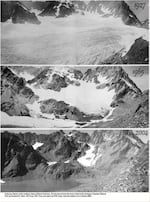
In March, 2014 waves crashed over the sea wall that protects the Quinault Indian Reservation at the mouth of the Quinault River. The tribe declared a state of emergency.
Courtesy, Larry Workman
The threat of climate change for the Quinault doesn’t end with sea level rise. About five years ago
, which contributes cool water to the Quinault River at critical times of year, disappeared for good. It had been receding since locals began photographing it, but Fawn Sharp still remembers the day when she saw that it was completely gone.
“In that moment I could feel my heart sinking, thinking that the glacier that feeds the mighty Quinault River has now disappeared.”
The absence of Anderson Glacier is already being felt. Very little snow fell on the Olympic Mountains this past winter, leading to minimal inputs of snowmelt into the Olympic Peninsula’s rivers, including the Quinault. Normally, glacial melt supplements river flows late in the summer and early fall.
But without the glacier, the Quinault River was lower than ever before recorded; so low that while walking through a newly-exposed stretch of river bed, one tribal member accidentally stubbed his toe on what turned out to be a mastodon jaw that may have been submerged since the last ice age.

Quinault tribal member David James, Jr. stubbed his toe on what turned out to be a baby mastodon jaw while walking through a shallow part of the Quinault River during this summer’s drought. The jaw may have been submerged since the last ice age.
Courtesy, Joe Schumacker
For the salmon that migrate home to cool, glacially-fed Northwest rivers like the Quinault, things were difficult this year.
Of the 700 people that live in the Quinault village of Taholah, almost half are directly dependent on salmon fishing. Shane Underwood stands at the Quinault fish processing facility he manages and looks out over the mouth of the Quinault River. Lines of gill nets stretch across different spots along the banks, each one representing a tribal family that has been catching returning salmon there for generations.
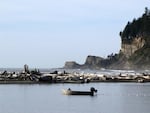
A Quinault tribal fisherman brings up his nets near the mouth of the river. Tribal families have worked the same fishing grounds along this river for generations.
Ashley Ahearn, KUOW/EarthFix
“That fishing ground over there. That ground belongs to my dad,” Underwood points across the water to a man in a small skiff pulling up his net. “My brother fishes that ground and he has a family of 10 people in his household that he has to support. His sole source of income is fishing.”
The warm ocean waters and dry summer have made for a confusing and hostile environment for salmon, who rely on cool river flows to find their way home to spawning grounds above Lake Quinault. Normally at this time of year with the chinook and coho running, the Quinault seafood plant processes 70,000 pounds of salmon per day. But Underwood said tribal fishers are catching half of that this season. The tribe has decided to stop fishing for the time being to help more salmon live long enough to spawn.

Chinook salmon on ice at the Quinault Indian Nation’s seafood plant. Salmon runs have been half the size they were in recent years. Some say low flows and warm ocean and river temperatures are to blame.
Ashley Ahearn, KUOW/EarthFix
Shane Underwood’s son David joins us by the river. He’s 23 and has been fishing since he was 7.
“It’s my favorite thing to do. I want my grandchildren to know what salmon are,” he said. “The rivers are a lot warmer now. Climate change could take all our salmon away. Climate change really worries me a lot.”
The average American will move 11 times in his or her lifetime, but Native American tribes are place based. David Underwood said it’s hard to explain what relocating would mean for his people.
“I don’t know what I would do. I don’t know what any of us would do. We wouldn’t be…” he paused for a long time, looking out over the river. “We’d pretty much be lost. This place, right here, where we are, is where my people have lived for thousands of years and each and every member of this tribe, we’re all proud Quinault tribal members, proud Native Americans. I don’t ever want to leave this place but if the ocean keeps rising we’re going to have to.&rdqu
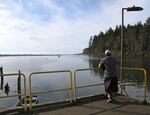
David Underwood has been fishing since he was 7. “Climate change could take our salmon away. I want my grandchildren to know what salmon are.”
Ashley Ahearn, KUOW/EarthFix
In her role as tribal council president, Sharp has represented her Quinault people at international climate talks before. She traveled to Poznan, Poland 9 years ago for a previous round of climate negotiations.
“Our goal was to engage the international community on including tribal governments, including tribal cultural knowledge and practices,” Sharp said.”So I thought to contend with a global crisis like climate change it’s important to include every segment of knowledge.”
The Quinault Indian Nation put together a climate adaptation and mitigation strategy at the time. It also had considered signing on to the
, which, as a sovereign nation, it was free to do, despite the fact that the U.S. did not sign the agreement.
Sharp saw an economic opportunity in the emerging European carbon market at the time of the Kyoto Protocol. If the tribe extended the rotation of tree harvest on its 200,000 acres of timberland it could have generated carbon credits to be sold on the European market.
“We set out to find potential partners but the following year the European market plummeted so for that reason and for other reasons we didn’t pursue it,” she said.
The Quinault did not sign on to Kyoto and Sharp says when she heads to Paris this November she won’t be going with a pen in hand to sign any international agreements. She’s long been a vocal leader for climate action but she has received some pushback from tribal members who say her leadership is needed at home on the reservation.
“It’s a balancing act because we have so many significant issues in any given tribal community.” Sharp said that she doesn’t just get phone calls in the middle of the night about sea level rise and flooded homes. She also gets calls about drug overdoses.
“We have our successes and we have our heartbreak and despair and the impacts of poverty, alcohol and drug addiction,” Sharp said. “It’s something that I really need to focus on and spend time here and work with the community strategically but I also serve as the president of the nation and I’m also the voice externally.&rdqu
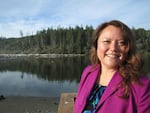
Fawn Sharp, tribal council president of the Quinault Indian Nation, has participated in international climate negotiations in the past but she says this year in Paris she’s eager to see where the conversation goes but won’t be signing any international climate deals.
Ashley Ahearn, KUOW/EarthFix
Sharp says she’s heartened by the increasing presence of representatives from island nations and other developing countries at the international climate gatherings in recent years. Indigenous peoples around the world are often on the front lines of climate change despite the fact that they contribute the smallest amount of greenhouse gases to the atmosphere.
Sharp says the international community should take note of that disparity and take responsibility.
"And if there are areas where a jurisdiction or an entire nation of people don’t have the capacity or financial wherewithal to contend with the issue," she said, "then there is a responsibility in other parts of the world to provide that aid and assistance.”